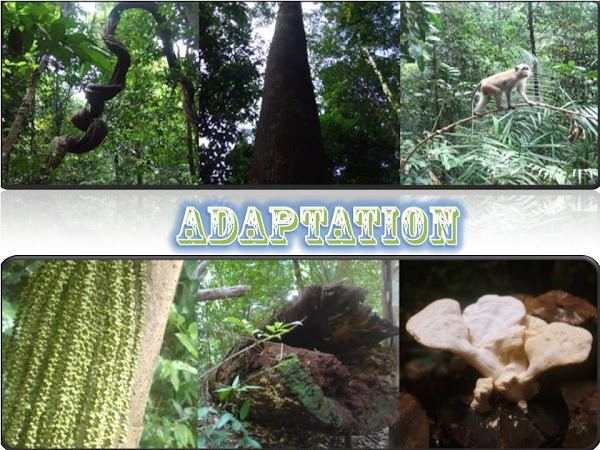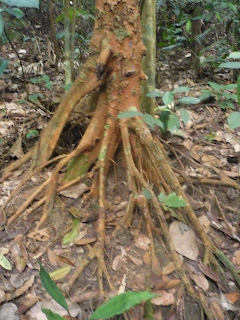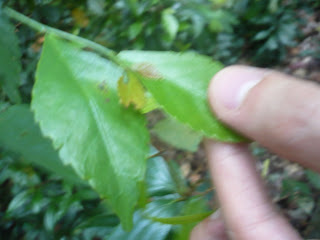Sunday, February 1, 2009
Post Fieldtrip Activity!
Right now, your task is to post a reflection entry on this blog. You may use the following questions below to guide you along:
1. Which plant would you use as an example to explain the concept of adaptation? Why?
2. Which is your favourite part of the fieldtrip? Explain.
You may make use of the photos your group has taken, and post it on the blog together with your reflection entry!
Have fun!
Wednesday, April 2, 2008
Discovering Rainforest - Part (1)
Plants in the tropical rainforest constantly have to adapt themselves in order to ensure that their basic needs---sunlight, water and nutrients are met.
We will be examining how the different parts of the plants and different types of plants have adapted to their environment (the tropical rainforest).
1. ROOTS (Needs: Water, nutrients)
Buttress roots are large roots on all sides of a tall or shallowly rooted tree.
These roots are common in tropical rainforests.
They are found in tropical rainforests as the soils are infertile so roots don't go deep.
The buttress roots prevent the tree from falling over and help gather more nutrients.
They are there to anchor the tree and soak minerals and nutrients from the ground, a function that would prove difficult if the tree was deeply rooted.
The roots interwind with other buttress roots from other trees and help to support all of the other trees surrounding it.
They can grow up to 4.572 meters tall and spread for approximately 30 metres above the soil. When the roots spread horizontally they cover a wider area to collect nutrients.
They stay near to the top because this is where all the main nutrients are.
The roots are close to the surface and can be seen to have spread over a large area
2. Epiphytes (Sunlight, water & nutrients)
Epiphytes are plants that live on the surface of other plants, especially the trunk and branches.
Most epiphytic seed plants are found in tropical rainforests because they require conditions of high humidity.
They grow on trees to take advantage of the sunlight in the canopy.
They do not absorb nutrients from the trees that they grow on.
For example, the bowl shape of an epiphyte called bird's nest fern catches leaves, bird droppings, and other organic matter the falls from above in a miniature compost heap.
The bird's nest fern is unique because its roots grow inward to absorb the collected nutrients.
Since epiphytes have no contact with the soil, the major difficulties they encounter are shortages of water and nutrients.
Many epiphytes have a waxy layer on their surfaces which reduces water loss.
The surface area from which water can be lost is often restricted by having small leaves. 
Some epiphytic mosses and lichens, in contrast, shrivel and stop growing when water is short, but when it becomes available they are able to absorb it rapidly and resume growth.
The stag's horn ferns trap falling leaves and other debris amongst their fronds (large and finely divided leaves).
Roots grow out from their stems into the decaying plant matter to absorb nutrients.
However, sometimes the epiphytes grow too densely on tree branches, causing the branch or even the entire tree to come crashing down.
Sometimes epiphytes can grow to be 1/3 the total weight of the tree they live on.
Many trees have smooth bark or shed their bark in order to discourage excessive epiphyte growth.
Sometimes rough barked trees contain toxins in their bark to control epiphyte growth.

3. Lianas / Climbers (Needs: Sunlight)

Lianas are thick woody vines (weak stemmed plants) that run from the forest floor to canopy and from tree crown to tree crown.
Lianas have their own roots systems, but depend on trees for support.
Since they are supported by other plants, lianas can use all of their energy on increasing their size. Some even grow to be 900 meters long.
Lianas begin their lives on the forest floor as seeds.
Once a vine begins to grow, it starts searching for a tree.
When it finds a tree, it begins to climb up the bark of the tree until it encounters light.
Once it reaches light, the vine grows, flowers, and produces fruit, completing the cycle.
Unfortunately, at times, lianas connect the surrounding trees too well; when one tree topples, it forces the surrounding trees to go down with it.
They have adapted to life in the rainforest by having their roots in the ground and climbing high into the tree canopy to reach available sunlight.
Sunday, February 3, 2008
Discovering Rainforest - Part (2)
These groups of living organisms are usually overlooked when people think of organisms in as rainforest. They are Fungi and Mosses!

Fungus / Fungi (Needs: Nutrients)
 Mosses Close-Up!
Mosses Close-Up!
Moss / Mosses (Needs: Nutrients, water)
We have looked at the plants in detailed. Now, let us look at the rainforest. How does it adapt to its environment?
Reproduction

- Some trees bear fruits. “Residents” in the park such as the Long-Tailed Macaque, Plantain Squirrels and many other animals feast on the fruits and thus, help to spread the seeds.
- Some plants reproduce by spores
Rainforest as a Whole
Compare the two following trees. Can you spot a major difference between them?

Yes, the tree in Picture (a) is tall and narrow whereas the tree in Picture (b) is short and widely branched out. Can you guess which tree belongs to a tropical rainforest?
Therefore, the answer is Picture (a)!
Nutrient Cycle
“The Rainforest can feed on itself.” Heard of this before? How does it manage to “feed” on itself?

Thus, you can see from the pictures above that organisms do thrive on decomposing materials such as rotting log, leaf litter and others.


We hope that after reading these two entries, you will have a better understanding of the Rainforest. The Rainforest is home to many plants and animals and we have no right to interfere their environment. It is actually a very fragile ecosystem and further pollution and interference from us may eventually kill it!
Thus, please protect the Rainforest! Let us keep it as a safe haven for the animals and plants living in it.
"Leave nothing behind but footsteps; Take nothing but pictures."
SOURCES:
Ramsey, D (2005). Retrieved Feb 14, 2008, from Specific adaptations in the Tropical Rainforest Web site: http://rainforest-australia.com/Tropical_Rainforest-Specific_Adaptions.htm
The Ever Green Project, (1997). Retrieved Feb 14, 2008, from Tropical Rainforest Plants Plant Adaptations Web site: http://www.hewett.norfolk.sch.uk/curric/NewGeog/Habitats/adapt.htm
Retrieved Feb 14, 2008, from What is Fungi? Web site: http://www.geocities.com/rainforest/andes/8046/whatis.html
Lam, P.K. Biology A Course for ‘O’ Level















